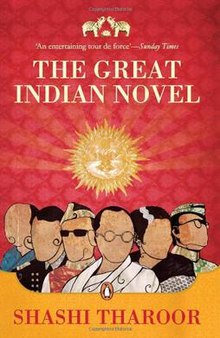The Great Indian Novel
Analysis of The Great Indian Novel by Shashi Tharoor – The Great Indian Novel is a satirical novel written by ShashiTharoor. ShashiTharoor is an Indian politician and a writer. Before coming into politics he was an international diplomat. Now he is serving as a Member of Parliament in the LokSabha in India. He has written fiction and non-fiction works of which 18 are bestselling. Most of his works are centred on India. He is also the author of columns of and articles in The New York Times, Newsweek, The Times of India and some more.
The Great Indian Novel is a fictional work which relies on the great epic of India the Mahabharatha. The characters of this epic are recast in the context of the Indian Independence Movement and three decades soon after that it. There are allusions to many other novels in English. The novel is divided into 18 books. The Mahabharatha is of 18 chapters, the Krukshetra war in the Mahabharatha is fought for 18 days. Bhagavad Geeta, the dialogue between Krishna and Arjuna and found in the central portion of the Mahabahratha, is also divided into 18 chapters. This is the first similarity of the novel and the epic. There are many more to follow.
Analysis – Analysis of The Great Indian Novel by Shashi Tharoor
Tharoor has used three devices to write this novel.
- Deviation from the original text
- Bringing in History with the epic
- Irreverent and Unorthodox perspective
DEVIATION FROM THE ORIGINAL TEXT
Mahabharatha translated to English means ‘The Great India’ and the name Tharoor has given to the novel is The Great Indian Novel. As already mentioned the novel is divided into 18 books but the titles that Tharoor gives for the books is a big deviation with a lot of mockery in the title. Let us examine a few titles. The first book is The Beginnings in the epic while in the novel it is Twice-Born Tale, Night is Darkness at Dawn, The Bed of Arrows for The Woman in the epic. Some of the titles are from the works of other famous novels. The first chapter is almost like the original and then from the second the deviations start with the introduction of Sir Richard a British in the kingdom of Hastinapura.
Tharoor has digressed from the original in many ways and that is the deliberate style which makes the book interesting. In the epic Pandu is cursed by a deer. He wounds a male deer during copulation. Since the deer is disturbed while mating, it curses Pandu that he will die when he has sex with his wife. Pandu has two wives and they refrain from having sex with him. At one weak moment he has sex with Madri his second wife and dies. Madri also kills herself as she is responsible for his death.
Analysis of The Great Indian Novel by Shashi Tharoor
Kunti brings up the five children, three her own and two of Madri’s. Tharoor writes than Pandu suffers from coronary thrombosis and sex might kill him. In the MahabharathaDirtharashtrahas hundred sons and one daughter. Tharoormakes it one daughter Priya Duryodhani who is equivalent to hundred sons. There are many such digressions in the novel and the worst can be Karna being depicted as a Muslim.
Tharoor has chosen an ancient text to portray his ideas. He realises that it cannot be served very true to its original story as it does not make sense to the reader. So there are large doses of history and enough digression to suit the taste of the modern reader.
HISTORY WITH THE EPIC
Some of the historic incidents incorporated into the novel are the Jallianwala Bagh massacre, the accession of Kashmir, the salt satyagraha and the partition of India. The post-independence incidents include the formation of ENA, the much criticised Emergency, formation of the Janata Government and the assassination of Indira Gandhi.
Jallianwala Bagh is called the Hastinpur Massacre or the Bibigarh Massacre. The salt satyagraha is called the Mango March. Karna is the Jinnah from history and Pakistan is called Karnistan. Priya Duryodhini who was equal to hundred sons (Kauravas) was to represent Indira Priyadarshini or Indira Gandhi , the strong woman in Indian politics and the only woman prime minister to date. The Janata Party led by Morarji Desai were the Pandavas. The novel does not provide the correct events from the epic but the inventiveness of the author has to be appreciated. The historical events chosen and relating it to the epic is truly a work of art.
IRREVERENT AND UNORTHODOX PERSPECTIVE
Veda Vyasa was a towering personality in the Indian mythology. He was born to Parashar a Brahmin and Satyavati, a fisher woman.He was the author of the Mahabharatha. But that was not all. He compiled the Vedas and wrote the Puranas making him one who has written the most number of extensive works. Such a person is the narrator of The Great Indian Novel but he is described in a lowly way. “…. born with a century, a bastard, but a bastardin a fine tradition, the offspring of a fisher woman seduced by a travellingsage.”
Though Drona appears in the Great Indian Novel he is described as a weakling while in reality he is the one who teaches the young princes of the Kuru dynasty. So too Bhishma is considered the grand sire in the epics who is torn between his role as a caretaker of the empire and love for his grandchildren. He was so powerful that only Krishna could ruffle him. He knew from whom his death would come and he could even decide when to die. Such a person is defiled in the Great Indian Novel. “………… an impotent old walrus sucking other reptiles, eggs, an infertile old fool seeking solace like calf from the udders of foreign cows, a man who is less than a woman”.
The list continues and in many places there are pornographic narration which undermines the established and respectful attitude towards the great epic. The decorum and dignity of the epic is played around with. The Geeta which is a message that is till date the best psychological treatment given is treated with triviality. Geeta is more than a psychological treatment; it is a manual on how to live life with the machine called Body Mind Intellect.
The Great Indian Novel breaks the tradition of novels in terms of technique and theme. It weaves a story with an epic, which is deeply sunk in the psyche of the Indians, as the warp and the documented history as the weft. It does not do justice to both, more so to the epic. However it is a piece of art as it is a word picture from a person with a highly creative mind. If it is read to enjoy its satire keeping all other emotions aside, it is worth the read.







